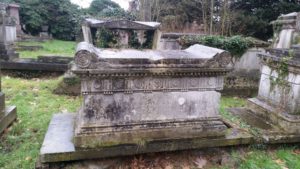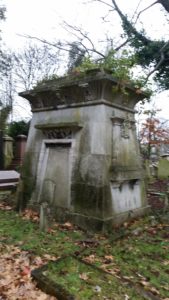London’s First Park Cemetery: Kensal Green Cemetery (1833)
Kensal Green was London’s first suburban cemetery, created like Green-Wood as a solution to the overcrowding and unsanitary conditions of the city’s churchyards. It was made possible by the Cemeteries Act of 1832, which allowed the creation of private cemeteries, offering a new funerary experience in which the dead might rest in pleasant, parkland surroundings. Although Kensal Green has now become part of West London, at that time it was still surrounded by fields and early visitors comment on the rural environment. Nevertheless, the industrialization that would eventually swallow it up was also key to the cemetery’s viability, since it was connected to the capital by canal (which runs along the south wall of the cemetery) and later by rail. Kensal Green would quickly be followed by other park cemeteries around London, notably Highgate in north London (1839) and Brookwood (1854, out in Surrey to the south) as well in Scotland (the Glasgow Necropolis likewise opening in 1833) and cities across England (such as Key Hill Cemetery in Birmingham, which opened in 1836).
The project was instigated by the newly-formed General Cemetery Company, which still runs the cemetery today. They brought 54 acres of ground, most of which was consecrated for Anglican burials, leaving most of the remaining space for ‘dissenters’, who received their own chapel.
Like Green-Wood, success was not immediate. Royal endorsement helped seal success. In 1843, the Duke of Sussex (son of King George III and Queen Victoria’s uncle) was buried here, quickly raising interest in the purchase of the plots around him. His sister, Princess Sophia, followed him in 1848. Although nowadays Highgate Cemetery is more associated with high profile interments, Kensal Green has its fair share of Victorian celebrities. Isambard Kingdom Brunel is buried here as is the novelist William Makepeace Thackeray and Robert Smirke, architect of the British Museum. Many stars of the nineteenth century are less familiar to us now but the periodicals of the time were continually reporting the funerals of actresses, musicians and other cultural figures here. They document not only the people who were laid to rest but also those, like Charles Dickens, who attended their funerals.
The tombs at Kensal Green are, on the whole, less impressive than those at Green-Wood, but as there the Classical style was popular. In British cemeteries, the classical was always fighting for attention with the Gothic, which became increasingly popular as the century progressed. As the earliest of the London cemeteries Kensal Green is a particularly good place to search for classical inspiration. The tone was set by the cemeteries’ buildings – although originally intended to be Gothic, the gate and both chapels were all built in Greek Revival style by John Griffith.

The classical forms at Kensal Green range from the mausolea that imitate temple architecture, through monumental tombs that recall sarcophagi and altars, down to obelisks, broken columns and draped urns. Some of the monuments closely resemble archaeological discoveries, such as the altar tombs from the Street of Tombs in Pompeii (excavated in the late eighteenth century); the gravestones (stelai) you might expect to see in the Kerameikos, the cemetery of Athens; or the sarcophagus of Scipio Barbatus (discovered to the south of Rome in the seventeenth century).

Mostly, though, the references are vaguer, with tombs incorporating architectural elements such as Egyptian or Greek columns, motifs such as downturned torches, and forms such as the obelisk. Various reasons may lurk behind their adoption; admiration of the grandeur of the ancient world; trust in the apparent immortality of classical style; emulation of the funerary culture of Pharaonic Egypt or imperial Rome; morbid fascination with ruins and the fall of civilizations; or perhaps just a penchant for following fashion. They stand among tombs of other inspiration: an Egyptian mausoleum might stand next to a Celtic cross or a Greek temple abut an elaborate medieval tomb. As a result, a walk through Kensal Green is a double journey into the past: on one level an exploration of the dead of Victorian London, on another a meditation upon past civilizations from antiquity onwards.
Additional Information:
Friends of Kensal Green’s website
Both sites have information about Kensal Green’s history, current happenings, its monuments and most famous occupants.
Blanchard, Samuel. The Cemetery at Kensal Green. London: Cunningham & Mortimer, 1857.
Clark, Benjamin. Hand-book for Visitors to Kensal Green Cemetery. London: Joseph Masters, 1843.
Justyne, William. Illustrated Guide to Kensal Green Cemetery. London: C. & E. Layton, 1873.
Early visitor accounts of Kensal Green.
Curl, James Stevens ed. Kensal Green Cemetery. The Origins and Development of the General Cemetery of All Souls, Kensal Green, London, 1824-2001. Chichester: Phillimore & Co., 2001.
The most comprehensive study of Kensal Green with an overview of the cemetery’s history, landscape and monuments.


